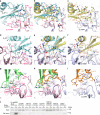Mechanism of self/nonself-discrimination in Brassica self-incompatibility
- PMID: 33004803
- PMCID: PMC7530648
- DOI: 10.1038/s41467-020-18698-w
Mechanism of self/nonself-discrimination in Brassica self-incompatibility
Abstract
Self-incompatibility (SI) is a breeding system that promotes cross-fertilization. In Brassica, pollen rejection is induced by a haplotype-specific interaction between pistil determinant SRK (S receptor kinase) and pollen determinant SP11 (S-locus Protein 11, also named SCR) from the S-locus. Although the structure of the B. rapa S9-SRK ectodomain (eSRK) and S9-SP11 complex has been determined, it remains unclear how SRK discriminates self- and nonself-SP11. Here, we uncover the detailed mechanism of self/nonself-discrimination in Brassica SI by determining the S8-eSRK-S8-SP11 crystal structure and performing molecular dynamics (MD) simulations. Comprehensive binding analysis of eSRK and SP11 structures reveals that the binding free energies are most stable for cognate eSRK-SP11 combinations. Residue-based contribution analysis suggests that the modes of eSRK-SP11 interactions differ between intra- and inter-subgroup (a group of phylogenetically neighboring haplotypes) combinations. Our data establish a model of self/nonself-discrimination in Brassica SI.
Conflict of interest statement
The authors declare no competing interests.
Figures




Similar articles
-
Comprehensive computational analysis of the SRK-SP11 molecular interaction underlying self-incompatibility in Brassicaceae using improved structure prediction for cysteine-rich proteins.Comput Struct Biotechnol J. 2023 Oct 20;21:5228-5239. doi: 10.1016/j.csbj.2023.10.026. eCollection 2023. Comput Struct Biotechnol J. 2023. PMID: 37928947 Free PMC article.
-
Characterization of the SP11/SCR high-affinity binding site involved in self/nonself recognition in brassica self-incompatibility.Plant Cell. 2007 Jan;19(1):107-17. doi: 10.1105/tpc.105.038869. Epub 2007 Jan 12. Plant Cell. 2007. PMID: 17220204 Free PMC article.
-
Commonality of self-recognition specificity of S haplotypes between Brassica oleracea and Brassica rapa.Plant Mol Biol. 2003 Jun;52(3):617-26. doi: 10.1023/a:1024819129785. Plant Mol Biol. 2003. PMID: 12956531
-
Molecular mechanism of self-recognition in Brassica self-incompatibility.J Exp Bot. 2003 Jan;54(380):149-56. doi: 10.1093/jxb/erg007. J Exp Bot. 2003. PMID: 12456765 Review.
-
Molecular aspects of self-incompatibility in Brassica species.Plant Cell Physiol. 2001 Jun;42(6):560-5. doi: 10.1093/pcp/pce075. Plant Cell Physiol. 2001. PMID: 11427674 Review.
Cited by
-
Genetic Diversity of Genes Controlling Unilateral Incompatibility in Japanese Cultivars of Chinese Cabbage.Plants (Basel). 2021 Nov 15;10(11):2467. doi: 10.3390/plants10112467. Plants (Basel). 2021. PMID: 34834830 Free PMC article.
-
Genetic and Molecular Characterization of a Self-Compatible Brassica rapa Line Possessing a New Class II S Haplotype.Plants (Basel). 2021 Dec 20;10(12):2815. doi: 10.3390/plants10122815. Plants (Basel). 2021. PMID: 34961286 Free PMC article.
-
Comprehensive computational analysis of the SRK-SP11 molecular interaction underlying self-incompatibility in Brassicaceae using improved structure prediction for cysteine-rich proteins.Comput Struct Biotechnol J. 2023 Oct 20;21:5228-5239. doi: 10.1016/j.csbj.2023.10.026. eCollection 2023. Comput Struct Biotechnol J. 2023. PMID: 37928947 Free PMC article.
-
The RGF/GLV/CLEL Family of Short Peptides Evolved Through Lineage-Specific Losses and Diversification and Yet Conserves Its Signaling Role Between Vascular Plants and Bryophytes.Front Plant Sci. 2021 Jul 20;12:703012. doi: 10.3389/fpls.2021.703012. eCollection 2021. Front Plant Sci. 2021. PMID: 34354727 Free PMC article.
-
Haplotype-resolved, gap-free genome assemblies provide insights into the divergence between Asian and European pears.Nat Genet. 2025 Aug;57(8):2040-2051. doi: 10.1038/s41588-025-02273-4. Epub 2025 Aug 6. Nat Genet. 2025. PMID: 40770574 Free PMC article.
References
-
- Bateman AJ. Self-incompatibility systems in angiosperms: III. Cruciferae. Heredity. 1955;9:53–68. doi: 10.1038/hdy.1955.2. - DOI
-
- Nou IS, Watanabe M, Isogai A, Hinata K. Comparison of S-alleles and S-glyeoproteins between two wild populations of Brassica campestris in Turkey and Japan. Sex. Plant Reprod. 1993;6:79–86. doi: 10.1007/BF00227652. - DOI
-
- Ruffio-Chable V, Gaude T. S-haplotype polymorphism in Brassica oleracea. Acta Hortic. 2001;546:257–261. doi: 10.17660/ActaHortic.2001.546.31. - DOI
-
- Takayama S, et al. Sequences of S-glycoproteins, products of the Brassica campestris self-incompatibility locus. Nature. 1987;326:102–105. doi: 10.1038/326102a0. - DOI
Publication types
MeSH terms
Substances
LinkOut - more resources
Full Text Sources
Research Materials

